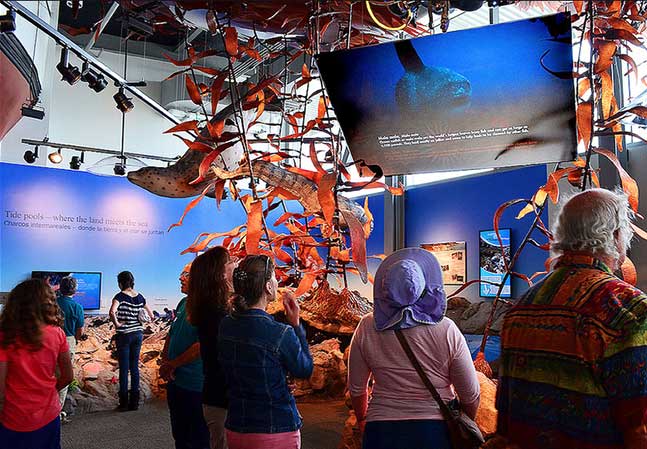 |
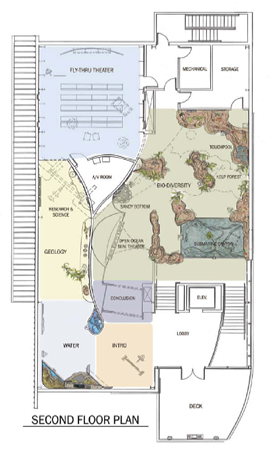 Exhibits
Exhibits
Exhibits are the heart of any interpretive facility. The Exploration Center uses state-of-the-art audio visual media to educate the public with several interactive video kiosks, film and touchable exhibits to engage the visitor.
Exploration Center Exhibits Walkthrough
Welcome to the Sanctuary
Visitors enter the center through the Lobby doors. Here they face an attractive stairway and elevator leading to the upper floor exhibits. Led up the stairs by the sound of wind, waves and gulls, visitors climb a stairway to a landing where there is a water-filled tank re-creating a part of the Monterey Submarine Canyon.
At the top of the stairs, visitors may go onto the deck or interact with an enticing video kiosk that describes the 14-site National Marine Sanctuary program. Nearby, a large relief map introduces the Monterey Bay National Marine Sanctuary and some of the activities going on in the area.
Sanctuary Introduction
On the Deck, visitors see an incredible view of the sanctuary! A mounted View Master shows historical photos of this area when it was a busy fishing port and other images of what the bay might look like if not for its protected status. Wall panels introduce coastal protection in the area and explain the design features and materials that qualify the building for a LEED (Leadership in Energy and Environmental Design) GOLD rating.
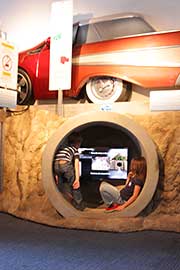 Where does your water go?
Where does your water go?
Back inside, visitors find life size model of a classic Chevrolet station wagon and Chevy Volt above a storm drain big enough for kids to climb into. A video of motor oil and other pollutants washing down the drain help visitors make the connection between what people do on land and what happens in the water. Graphic panels nearby define and describe this watershed and explain why clean water is so vital to life. The panels discuss the sanctuary's water quality monitoring program and talk about ways in which visitors can make a difference in their watersheds.
Sanctuary Research
In the Geology Gallery, a rear projected computer-generated map of the MBNMS allows the visitor to explore 15 significant sites in the sanctuary. Visitors use a track pad to scroll across the screen that describes the sanctuary's features as they go. A wall mural follows the elevation of the sanctuary with underwater geologic features to familiar, graspable landmarks. On a nearby counter, a rock sample from the extinct Davidson volcano sits alongside touchable objects from sanctuary. A boat hull atop the gallery wall "tows" a multi-beam sonar device, The visitor engages in an interactive to map significant wrecks like the Macon dirigible or Montebello ship.
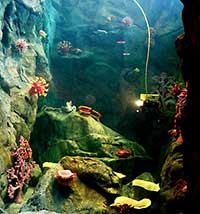 Exploration Theater
Exploration Theater
In the theater, visitors are immersed under the sea surface of the sanctuary with a phenomenal film by Bob Talbot. The theater is a multi-purpose room with flexible seating. It is be capable of projecting real-time video, slides, DVDs and computer-based presentations and will has audio equipment for guest speakers.
Biodiversity - Intertidal Touchpool
Exiting the theater, visitors are drawn to a beautifully re-created Rocky Tide Pool surrounded by wall murals that continue the view out across the sanctuary. One section is specially designed as a discovery area for small children featuring tidepool animals. The central pool is filled with detailed models of tidepool animals and an interactive video kiosk.
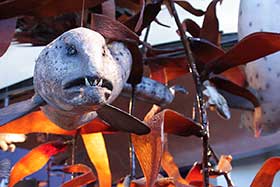 Biodiversity - Kelp Forest
Biodiversity - Kelp Forest
Across from the touch pool, visitors are immersed in a lush, rocky-bottom-to-ceiling Kelp Forest populated by models of kelp forest fishes, marine mammals, an eel and a diver. Touchable model holdfasts, sea stars, crabs and abalone are on the bottom. A visitor can learn stories about each kelp forest animal by touching a photo on a screen or exploring the zones in a kelp forest on a large, rear-projection screen.
Biodiversity - Submarine Canyon
Across from the kelp, visitors can look over into a two-story Submarine Canyon they saw from the landing. From here, the visitors can operate a remotely operated vehicle (ROV) robot to find deep sea animals from the Monterey Submarine Canyon or the Davidson Seamount. As the rocks give way to a Sandy Seafloor, an overhead fishing boat trails a purse seine full of squid. Graphics explain the history of fishing in the area and the sustainable squid fishery. sustainability in this area. The interactive video here compares historical and contemporary fishing.
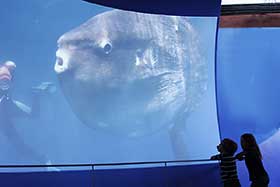 Open-Ocean Mini-Theater
Open-Ocean Mini-Theater
A large curved screen draws the visitor into an Open-Ocean Mini-Theater where they view stunningly beautiful footage that uses migratory species such as Ocean sunfish, dolphins and whales to tell the story of the three seasons of the sanctuary.
This is your Sanctuary
In conclusion, visitors pass between a bank of monitors featuring images of the sanctuary's animals, reinforcing the message "This is your sanctuary, treat it gently." The second shows human activities and models positive behaviors to support the message "This is your sanctuary, do your part to protect it." They see a collage of action photos including surfing, kayaking, whale watching, fishing, SCUBA diving, beachcombing, tide pooling and bird watching. Who knew there was so much to do in the MBNMS? Once back in the lobby, visitors may purchase marine-related merchandise from the Gift Shop or pick up maps to the MBNMS and other National Marine Sanctuaries.
